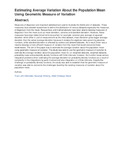| dc.contributor.author | Troon, John Benedict | |
| dc.contributor.author | Karanjah, Anthony | |
| dc.contributor.author | Alilah, Anekeya David | |
| dc.date.accessioned | 2021-12-31T08:28:00Z | |
| dc.date.available | 2021-12-31T08:28:00Z | |
| dc.date.issued | 2020-08-25 | |
| dc.identifier.uri | https://doi.org/10.11648/j.ijsd.20200602.11 | |
| dc.identifier.uri | https://www.sciencepublishinggroup.com/journal/paperinfo?journalid=379&doi=10.11648/j.ijsd.20200602.11 | |
| dc.identifier.uri | http://ir-library.mmust.ac.ke:8080/xmlui/handle/123456789/1942 | |
| dc.description.abstract | Measures of dispersion are important statistical tool used to illustrate the distribution of datasets. These measures have allowed researchers to define the distribution of various datasets especially the measures of dispersion from the mean. Researchers and mathematicians have been able to develop measures of dispersion from the mean such as mean deviation, variance and standard deviation. However, these measures have been determined not to be perfect, for example, variance give average of squared deviation which differ in unit of measurement as the initial dataset, mean deviation gives bigger average deviation than the actual average deviation because it violates the algebraic laws governing absolute numbers, while standard deviation is affected by outliers and skewed datasets. As a result, there was a need to develop a more efficient measure of variation from the mean that would overcome these weaknesses. The aim of the paper was to estimate the average variation about the population mean using geometric measure of variation. The study was able to use the geometric measure of variation to estimate the average variation about the population mean for un-weighted datasets, weighted datasets, probability mass and probability density functions with finite intervals, however, the function faces serious integration problems when estimating the average deviation for probability density functions as a result of complexity in the integrations by parts involved and also integration on infinite intervals. Despite the challenge on probability density functions, the study was able to establish that the geometric measure of variation was able to overcome the challenges faced by the existing measures of variation about the population mean. | en_US |
| dc.language.iso | en | en_US |
| dc.publisher | International Journal of Statistical Distributions and Applications | en_US |
| dc.subject | Estimating ,Average, Variation, Population, Mean,Geometric, Measure | en_US |
| dc.title | Estimating Average Variation About the Population Mean Using Geometric Measure of Variation | en_US |
| dc.type | Article | en_US |

